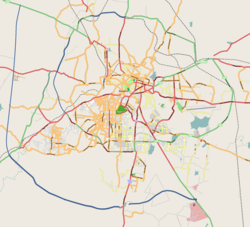Cox Town, Bangalore
Sarvagnanagara | |
|---|---|
Neighborhood | |
| Coordinates: 12°59′39″N 77°37′27″E / 12.9940515°N 77.6242794°E | |
| Country | India |
| State | Karnataka |
| District | BBMP (North) |
| Metro | Bangalore |
| Government | |
| • Body | BBMP |
| Languages | |
| • Official | Kannada |
| Time zone | UTC+5:30 (IST) |
| PIN | 560005 |
| Lok Sabha Constituency | Bangalore Central |
| Vidhan Sabha Constituency | Sarvagnanagar |
| Original Planning Agency | Bangalore Civil & Military Station Municipal Commission |
Cox Town, Bengaluru is a neighborhood of the Bangalore Cantonment,[1] located in the central part of the city and named after the last Collector and District Magistrate of the Bangalore Civil and Military Station, Alexander Ranken Cox (A R Cox), Indian Civil Services.[2][3] It is one of the suburbs which came out of the plan to de-congest thickly populated areas of the Bangalore Cantonment after the bubonic plague. Agricultural fields were converted for this purpose, and town was planned according to modern hygienic standards, with drainage and conservancy conveniences.[2] Sarvagnanagara is bound by the Bangalore-Madras Railway line on the North and East, Wheeler Road in the East and the Ulsoor Polo Ground in the South.[2] It consists of posh localities like Heerachand Layout and other localities like Sindhi Colony, Jeevanahalli, Doddigunta, and roads such as Assaye Road, Charles Campbell Road, Wheeler Road, etc. and is adjoining the suburbs of Pulakeshi Nagara, Sri Krishnaraja Wadiyar Nagara and Cooke Town, with easy access to the Bengaluru East Railway Station, Halasuru, Lingarajapura, Shivajinagara. Sarvagnanagara is a well planned, posh and preferred locality in the Bangalore Cantonment, created during the British Raj.[4] The residents of Sarvagnanagara follow a liberal 'live a let live' attitude, with suburb still retaining much of its green cover, without excessive commercialisation.[5] In 1988, the BBMP renamed Cox Town as Sarvagnanagara, after a 16th-century saint poet.[6] [7][8][9][10]
- ^ Johnson, Ronnie. "Bangalore around the late 1920s ..." Children of Bangalore. Archived from the original on 5 January 2015. Retrieved 5 January 2015.
- ^ a b c Pani, Narendar; Radhakrishna, Sindhu; Bhat, Kishor G (1 August 2008). Bengaluru, Bangalore, Bengaluru: Imaginations and Their Times. SAGE Publications India. p. 180. ISBN 9788132105435. Retrieved 8 January 2015.
- ^ Cite error: The named reference
Harshitha-Coxwas invoked but never defined (see the help page). - ^ R, Aarthi (7 September 2010). "Cox Town - a posh ward once, now a problem area". The Times of India. No. Bangalore. Retrieved 6 January 2015.
- ^ Singla, Tania (6 July 2013). "Cox Town's managed to retain its community fabric: Biju Cherayath". The Hindu. No. Bangalore. Retrieved 6 January 2015.
- ^ Prashanth, G N (14 April 2011). "It's all in the new name". The Times of India. No. Bangalore. Retrieved 23 December 2014.
- ^ Narasimhan, Sakuntala. "Road names change, roads don't". Citizen Matters. Retrieved 23 December 2014.
- ^ "What's in a name? Perhaps, the past". The Hindu. No. Bangalore. 21 September 2012. Retrieved 5 January 2015.
- ^ "Sights, sounds and smells from Bangalore". Bangalore Buzz. 15 September 2005. Retrieved 5 January 2015.
- ^ Cite error: The named reference
Sujawas invoked but never defined (see the help page).
